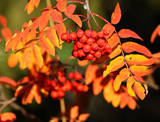Autumn bounty expected
Early signs point towards a bumper autumn berry crop this year, according to experts


Last year's autumn-berry crop was the most dismal in more than a decade, but 2013's looks set to be a bumper one, early reports suggest.
The Woodland Trust has predicted that brambles, rowans and blackthorns, among others, will fruit abundantly, due to the combined effects of the heatwave we enjoyed earlier in the summer and the wet spells it was interspersed with. However, it's thought that we may be waiting a little longer than usual for autumn's real glory, thanks to the late onset of spring flowering.
The news has delighted conservationists. ‘Last year, birds and mammals suffered some of the poorest fruiting crop in years, and this, coupled with the prolonged cold snap in spring, meant that many species had to endure a long period without a decent food supply,' says the Woodland Trust's Dr Kate Lewthwaite. ‘They will finally be able to enjoy an autumn feast.' Valerie Osborne of the RSPB is similarly enthusiastic: ‘It'll be a real bonus. And with any luck, a bumper crop will last throughout the winter, which will be great for visitors such as redwings and fieldfares. We'll be able to see them for longer, too.'
Garden owners and their staff are also relieved. ‘Last year was pretty poor, so we're hoping to see lots more colour,' says dendrologist Dan Crowley of The National Arboretum at Westonbirt in Gloucestershire (01666 880220; www.forestry.gov.uk/westonbirt). ‘The walnuts are fruiting very heavily at the moment-if all the sights and smells come together, it'll be a real riot.' Westonbirt is offering guided walks on October 6 and 12 showcasing the spectacular autumn fruits and berries.
In the north of the county, the team at Hidcote (www.nationaltrust.org. uk/hidcote; 01386 438333) has been greatly cheered by the prospect of trees in full fruit. ‘It would be fantastic for us,' says general manager Mike Beeston. ‘We have some lovely yew trees and hollies, as well as mountain ash and sorbus, which will create a spectacular rainbow.' An autumn ramble with the head gardener, followed by a lunch making the most of the season's bounty, is planned for November 9.
The Woodland Trust's predictions are based on data collected by members of the public as part of its Nature's Calendar project. Volunteers submit sightings of autumnal ‘tells', such as ripening fruits and changing leaf tints, which help scientists better understand how plants and flowers are adapting to climactic shifts. To contribute, visit www.naturescalendar.org.uk
The NFU wants your opinions
Sign up for the Country Life Newsletter
Exquisite houses, the beauty of Nature, and how to get the most from your life, straight to your inbox.
The NFU is asking its members to help put together an accurate picture of this year's harvest. Its annual survey, which was launched last week and can be completed online at www.nfuonline.com, aims to reflect issues such as the effects that difficult field conditions and extreme weather have had on crops- a recent item on Countryfile showed an incongruously red vista of rape, created by rogue poppies thriving while the crop itself is behind.
‘We rely on members' input in order to maintain our accurate track record with harvest results,' explains the NFU's chief arable adviser, Guy Gagen. ‘Without the information provided by them, it would have simply been impossible to generate an accurate estimate in the past.'
The survey is published up to a month before Defra's official statistics, making it the first source of published information on production levels.
* Follow Country Life magazine on Twitter
Emma Hughes lives in London and has spent the past 15 years writing for publications including the Guardian, the Telegraph, the Evening Standard, Waitrose Food, British Vogue and Condé Nast Traveller. Currently Country Life's Acting Assistant Features Editor and its London Life restaurant columnist, if she isn't tapping away at a keyboard she's probably taking something out of the oven (or eating it).
-
 New balls please: Eddie Redmayne, Anna Wintour and Laura Bailey on the sensory pleasures of playing tennis
New balls please: Eddie Redmayne, Anna Wintour and Laura Bailey on the sensory pleasures of playing tennisLittle beats the popping sound and rubbery smell of a new tube of tennis balls — even if you're a leading Hollywood actor.
By Deborah Nicholls-Lee
-
 A rare opportunity to own a family home on Vanbrugh Terrace, one of London's finest streets
A rare opportunity to own a family home on Vanbrugh Terrace, one of London's finest streetsThis six-bedroom Victorian home sits right on the start line of the London Marathon, with easy access to Blackheath and Greenwich Park.
By James Fisher